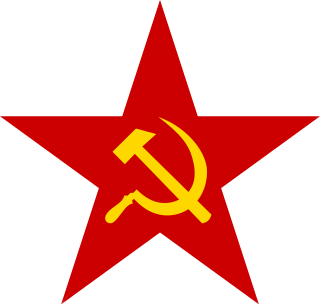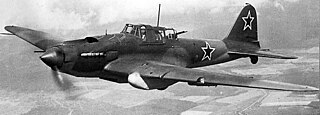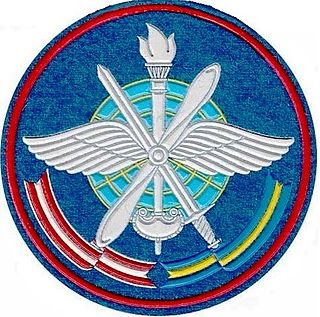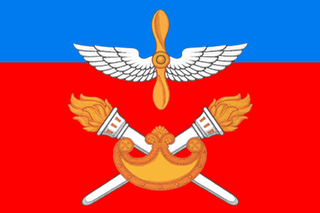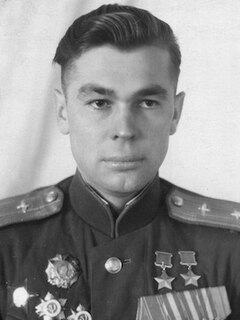
Vladimir Avramovich Aleksenko was an attack aviation squadron and regimental commander during the Great Patriotic War and a double Hero of the Soviet Union. He was awarded his first Hero of the Soviet Union award for making 230 attack sorties. His second award was for making another 72 attack sorties. During World War II, Aleksenko made a total of 292 attack sorties. Aleksenko became a Lieutenant general postwar after graduation from the Military Academy of the General Staff. Between 1967 and 1974, he commanded the 5th Air Army.
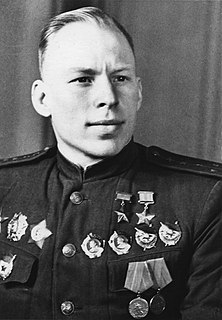
Aleksey Vasilyevich Alelyukhin was a Soviet Air Force major general, World War II flying ace and double Hero of the Soviet Union. During World War II, Alelyukhin shot down at least 28 enemy aircraft. He served in the 9th Guards Fighter Aviation Regiment and went on to a series of postwar command positions, retiring as a major general in 1985. He also flew during the Korean War.

Pavel Mikhailovich Kamozin was a Soviet Air Force Captain and double Hero of the Soviet Union. Kamozin became a pilot in the Soviet Air Force before World War II and was flying Polikarpov I-16s in June 1941. After being wounded in the foot on the second day of the war he was sent to become an instructor but returned to the front in the fall of 1942. By the end of April 1943 Kamozin had reportedly shot down 12 enemy aircraft. For this action he was awarded his first Hero of the Soviet Union award. By 1 July 1944, when he was awarded his second Hero of the Soviet Union award, Kamozin had reportedly shot down 29 enemy aircraft. In January 1945 his Bell P-39 Airacobra crashed due to an engine failure and Kamozin was severely wounded. He reportedly claimed 35 victories during the war. Postwar, he worked in civil aviation in Bryansk.

Vasily Ilyich Mykhlik was an aviation commander of the Soviet Army and pilot during the Great Patriotic War, twice Hero of the Soviet Union and recipient of several other awards.

Vasily Vasilyevich Glagolev was a Red Army Colonel general, Hero of the Soviet Union, and commander of the Soviet airborne (VDV). After initially serving in the Imperial Russian Army during World War I, Glagolev joined the Red Army in 1918. He rose to command the 42nd Cavalry Division on the Crimean Front in World War II, going on to command the 73rd and 176th Rifle Divisions as well as the 10th Guards Rifle Corps. Glagolev briefly became the commander of the 9th Army in February 1943 before being transferred to command of the 46th Army, which he would lead until May 1944. He became the 31st Army's commander and led it during the Vitebsk–Orsha Offensive. In January 1945, Glagolev commanded the 9th Guards Army, composed of Soviet airborne divisions converted into infantry. In April 1946, he became the commander of the Soviet airborne forces and died on in 1947 during exercises.

Konstantin Antonovich Abazovsky was a VVS lieutenant and Hero of the Soviet Union. Abazovsky was a flight commander in the 190th Attack Aviation Regiment and was killed in a dogfight on the same day that he was awarded the title Hero of the Soviet Union. He fought in the Baltic Offensive.

Dmitry Alexandrovich Medvedev was a Soviet Air Force Lieutenant general and Hero of the Soviet Union. During World War II, Medvedev was credited with 14 victories. He also fought in the Battles of Khalkhin Gol and the Winter War. After World War II, Medvedev served in the Strategic Missile Troops as commander of the 7th Separate Guards Missile Corps.
Vasily Nikolayevich Bantsekin was a Red Army soldier during World War II and a Hero of the Soviet Union. He was awarded the title Hero of the Soviet Union and the Order of Lenin for his actions during Operation Kutuzov and the Chernigov-Pripyat Offensive.

Mikhail Ivanovich Kuchinsky was a Belarusian Soviet Air Force Lieutenant colonel and Hero of the Soviet Union. Kuchinsky was awarded the title Hero of the Soviet Union and the Order of Lenin for his actions during World War II as deputy commander of a squadron in the 218th Attack Aviation Regiment from 1943. He continued his Air Force service postwar and worked in a factory following his retirement from the military.
Andrei Ivanovich Girich was a Ukrainian Soviet Air Force major general and Hero of the Soviet Union. Girich claimed at least 17 victories against German aircraft during World War II. He was a squadron commander in the 486th Fighter Aviation Regiment during the war.
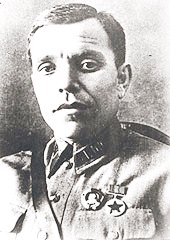
Konstantin Ivanovich Provalov was a Soviet Army Colonel general and Hero of the Soviet Union. Provalov was awarded the title Hero of the Soviet Union and the Order of Lenin for his leadership of a regiment in the Battle of Lake Khasan. After Operation Barbarossa, Provalov became the commander of the 383rd Rifle Division. He led the division during the Battle of the Caucasus. In 1943, he became commander of the 16th Rifle Corps and fought in the Kerch–Eltigen Operation and Crimean Offensive. In May 1944, Provalov transferred to command the 113th Rifle Corps and led it during the Vitebsk–Orsha Offensive. In July he became commander of 36th Rifle Corps, which fought in the Minsk Offensive, the Gumbinnen Operation, the Battle of Königsberg and the Prague Offensive. Postwar, Probalov led the 3rd Guards Rifle Corps, 9th Guards Rifle Corps, 13th Rifle Corps and 31st Special Rifle Corps. In 1958, he became commander of the 4th Army. From 1962 to 1968 he led the Southern Group of Forces.

Konstantin Mikhailovich Kabanov was a Soviet Air Force Colonel and Hero of the Soviet Union. After graduating from flying school in 1944, Kabanov was sent to the front and made 27 attacks on Danzig. He reportedly made a total of 103 attack sorties during the war flying Ilyushin Il-2 attack aircraft, for which he was awarded the title Hero of the Soviet Union. Postwar, Kabanov continued to serve in the Air Force and became a test pilot and later engineer at the Air Force Research Institute.

Nikolay Ivanovich Rodin was a Soviet Air Force colonel and Hero of the Soviet Union. Rodin was awarded the title for reportedly making 110 attack sorties in World War II between November 1943 and April 1945. Postwar, he continued to serve in the Soviet Air Force before a 1978 retirement. Rodin lived in Leningrad/St. Petersburg and died in 2002.

Nikolay Nikolayevich Oleshev was a Soviet Army lieutenant general and Hero of the Soviet Union. Oleshev volunteered for the Red Army in 1918 and served in the Russian Civil War as a clerk at a field hospital. In late 1921 he became a Cheka officer. During the interwar period Oleshev was an officer in the Soviet Border Troops.
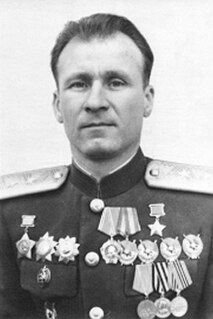
Andrey Matveyevich Andreyev was a Soviet Army Colonel general and Hero of the Soviet Union. Andreyev joined the Soviet Border Troops in 1924 and became an officer. After graduating from the Frunze Military Academy, he was given command of a border detachment. Andreyev fought in the Winter War as commander of a ski regiment of the border troops. After spending the first months of World War II as logistics chief of the 23rd Army, he was appointed to command the 43rd Rifle Division in September. In late October he took command of the 86th Rifle Division, fighting in the Nevsky Pyatachok. In April 1942 Andreyev became deputy commander of the 23rd Army and then the 42nd Army in May. He became commander of a special group in the 42nd Army's Staro-Panovo Offensive, in which he was wounded.
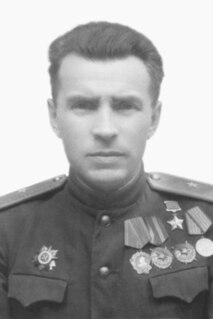
Leonid Alexandrovich Kolobov was a Soviet Army Lieutenant general and Hero of the Soviet Union. After being drafted into the Red Army in 1928, Kolobov graduated from the Moscow Infantry School and became an officer. In 1940 he became chief of staff of a Finnish People's Army infantry division. In September 1941, Kolobov became chief of staff of the 408th Rifle Division in Iran. From September 1942 he commanded the 389th Rifle Division. He led the division until the end of the war, being awarded the title Hero of the Soviet Union for his leadership in the Lvov–Sandomierz Offensive. Postwar, he led the 97th Guards Rifle Division, 114th Guards Airborne Division, 86th Guards Rifle Division and 4th Guards Army Corps. Kolobov also served as an adviser in East Germany during the 1950s. He retired in 1969, lived in Moscow and died in 1993.
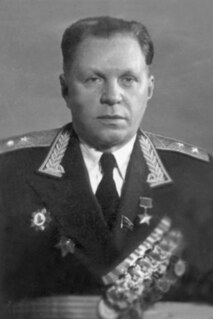
Daniil Vasilievich Kazakevich was a Belorussian Soviet Lieutenant general and Hero of the Soviet Union. Kazakevich was drafted into the Red Army in 1920 and fought in the Polish–Soviet War. In 1923 he transferred to the Soviet Border Troops. Kazakevich became an officer and by 1939 was chief of staff of a border district in the Soviet Far East. In December 1942 he became chief of staff of the Far Eastern NKVD Rifle Division, which became the 102nd Rifle Division some months later. After fighting in Operation Kutuzov, Kazakevich was given command of the 399th Rifle Division in September 1943. Kazakevich led the division through the Battle of the Dnieper, Operation Bagration and the East Prussian Offensive. He was awarded the title Hero of the Soviet Union for his leadership in the battle for the Narew bridgeheads during September 1944. Postwar, Kazakevich returned to the Border Troops and led the Moldovan and Southwestern Border Districts. After a two-year period as an advisor to the East German Border Troops, Kazakevich became chief of the Border Troops military educational institutions. He retired in 1959 and lived in Moscow, working in the Intourist Directorate.

Yevgeny Petrovich Fyodorov was a Soviet Air Force major general and double Hero of the Soviet Union. From 1933 Fyodorov served as a pilot in a Long Range Aviation regiment. He was a squadron commander during the Winter War and was awarded the title Hero of the Soviet Union for conducting bombing sorties. Fyodorov served with Long Range Aviation during World War II and was awarded the title Hero of the Soviet Union a second time for making strategic bombing sorties in June 1945. Fyodorov retired as a major general in 1958 and lived in Leningrad, where he worked at the airport.
Vasily Grigoryevich Kabanov was a Red Army major and Hero of the Soviet Union. Drafted into the Red Army in 1930, Kabanov fought in the Battle of Lake Khasan and the Battles of Khalkhin Gol as a tank company Politruk. After being seriously wounded in fighting around Leningrad, he took refresher courses at the Red Army Military Academy of Mechanization and Motorization. Kabanov returned to the front in January 1945 as a tank battalion commander and fought in the Vistula–Oder Offensive, where his battalion helped take Skierniewice. For his leadership, Kabanov was awarded the title Hero of the Soviet Union. He was mortally wounded during the Battle of Berlin.
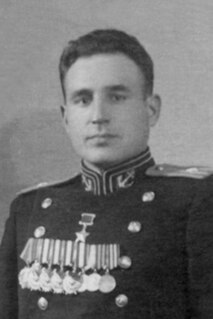
Yevgeny Ivanovich Kabanov was a Soviet Naval Aviation major general and Hero of the Soviet Union. During World War II, Kabanov served as a bombardier, gunner and navigator in a dive bomber aviation regiment of the Baltic Fleet. He fought in the Siege of Leningrad, the Baltic Offensive, and the Battle of Königsberg. Kabanov was awarded the title for making 103 Petlyakov Pe-2 sorties by June 1944. Postwar, Kabanov became chief navigator of the Black Sea Fleet Air Force, the 8th Fleet Air Force, and the 9th Fighter Aviation Corps. Between 1956 and 1974, Kabanov was chief navigator of Soviet Naval Aviation. He retired in 1974 with the rank of Major general and worked at GosNIIAS. He died in 1989.




